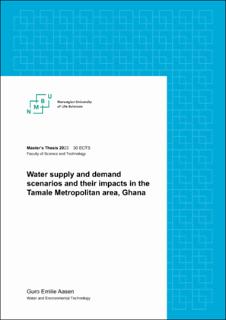| dc.description.abstract | Abstract
Water as a resource is extremely important for all life. Still, 26% of the world’s population
lacks access to a safely managed drinking water service. The part of the population that lacks
access is disproportionately spread and Africa is suffering water scarcity the most. With the
ever-growing population and effects of climate change, water scarcity and shortages will only
be exacerbated. Unfortunately, there are not many studies about the effect climate change has
on water resources systems in SSA.
This thesis aims to evaluate and manage potential challenges in urban drinking water supply
in the coming decades in the Tamale Metropolitan area. The methods used to acquire results
were data acquisition and WEAP Modelling. The modelling resulted in multiple models. One
model simulated the future water supply and demand situation with three different annual
population growth rates, 2.1%, 3.7% and 5.0%. This model also simulated what would happen
to the coverage if the maximum capacity of the transmission link was reduced by 10% and
20%. Four models were developed to provide options for managing the drinking water supply
and demand situation, namely the improvement models.
The current challenges to the potable water supply in Tamale Metropolis were found to be
unsatisfactory drinking water supply. The reasons for the water supply being unsatisfactory
were found to be water loss, operational challenges, and population growth.
If the population increases by 2.1%, 3.7% and 5.0% annually, the coverage will decrease
substantially. In 2021 the coverage was around 35%. In 2050 however, the coverage was 19%
for the scenario where the annual population growth rate was 2.1%. For the scenario where
the annual population growth rate was 3.7%, the coverage in 2050 was 12%. Lastly, when the
annual population growth rate was 5.0%, the coverage was 8%. To see the effects the factors
influencing the catchment has on the urban water supply, a reduction of 10.0% and 20.0%
maximum capacity was simulated. The results of these simulations show that this impacts the
supply negatively.
Lastly, the thesis centers on the possibility of managing the weaknesses/challenges of the
drinking water supply so that the coverage will increase in the predictable future. Here the
challenges are water loss and reuse rate, and transmission link capacity. By developing the
improvement models, it was discovered that all actions increase the coverage, but to different
extents. The highest increase occurs in the TL, loss rates and reuse rate model, where the
average coverage in 2021 was 82%, and in 2050 varied between 20-45% based on what PGR
was used. | |
